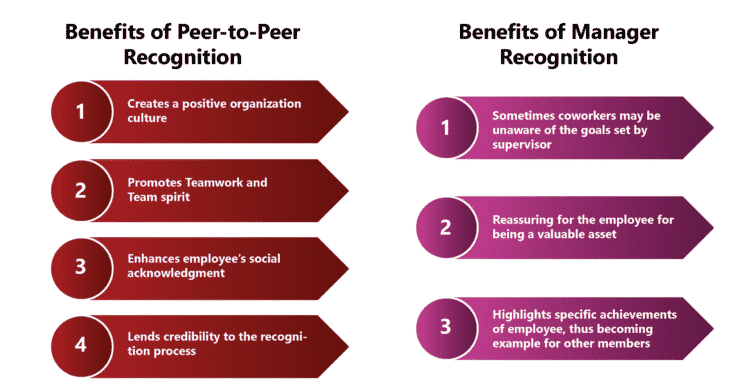1. Peer-to-peer recognition is increasingly popular for boosting employee engagement and creating a positive work culture, as employees consider it more unbiased and credible.
2. Manager recognition remains essential, especially for acknowledging specific achievements and setting examples for others, though it is sometimes perceived as less transparent.
3. Peer-to-peer recognition enhances teamwork, social acknowledgment, and a sense of satisfaction, while manager recognition reassures employees of their value to the organization.
4. A balanced approach, combining peer-to-peer and manager recognition, is essential for a successful employee recognition program that motivates and engages the workforce.
The two most commonly used employee recognition methods are Peer-to-Peer Recognition and Manager Recognition. However, there is always a debate about which method is more effective for an organization.

As the name suggests, peer-to-peer recognition is the method of recognition, where the employees are appreciated by their co-workers for their effort, contribution and support towards business growth.
Despite being a relatively new tool for appreciating employees, it is becoming increasingly popular across organizations as a very effective method of recognition for boosting employee engagement and motivation.

This is because it is based on a relatively unbiased assessment of the employee’s performance and behavior by those who work with them regularly.
This lends greater credibility to this employee recognition strategy in the eyes of the entire workforce, making it more satisfying for the recipient.

A study has revealed that peer-to-peer recognition programs are used in nearly 41% of organizations.
In fact, Globoforce Employee Recognition Survey has established the fact that aside from making employees feel satisfied, this method of recognition also helps to improve customer satisfaction.
Employees get a greater sense of satisfaction, self-worth, acknowledgment, and achievement when recognized and appreciated by their peers
There are situations where peer-to-peer recognition can provide more significant benefits:

Peer-to-peer recognition promotes a work culture where employees praise their co-workers and appreciate their accomplishments in a frank and transparent manner.
The employees learn to interact and openly share their views and opinions about various aspects of work and the organization.
Hence, this helps create a more friendly and cordial workplace environment and promotes strong interpersonal bonding between employees.
The overall result is the creation of a positive work culture.

Peer recognition helps in fostering a deep sense of collaboration and camaraderie among employees.
This, in turn, helps significantly reduce discord and differences between employees, enabling coworkers to resolve their disputes over work issues without the intervention of the management.
It fosters team spirit, making employees genuinely supportive of each other.

Also, their co-workers’ recognition fills the employees with a deep sense of satisfaction and gratitude.
They experience positive energy and happiness due to the affirmation and acceptance of their colleagues.
Hence, receiving appreciation from co-workers makes the whole recognition process more meaningful.

Also, the employee recognition process can drive results provided that are truly transparent and unbiased.
Peer-to-peer recognition offers organizations the best way to achieve this objective.
Hence, apart from enhancing trust and camaraderie among employees, it makes employee recognition transparent and fair.

In this method, acknowledging and rewarding the employees rests primarily with their managers and supervisors.
The managers use various criteria to identify candidates worthy of recognition. They then select the ones who outshine the others based on specific pre-defined parameters.
Despite being a traditional employee recognition policy, it is losing its sheen in modern organizations as a significant percentage of employees do not perceive it to be unbiased.

However, many employees consider this method unreliable because they believe the managers are not entirely aware of their competence and capabilities and have preconceived notions about them.
Managers who regularly recognize the performance of their employees can contribute towards improving engagement by roughly 60% as suggested by Turbocharging Employee Engagement: The Power of Recognition from Managers, as it helps to enhance employees’ well-being.

Despite the growing popularity of peer-to-peer recognition, the importance of employees being recognized by managers cannot be undermined.
There are a few scenarios at the workplace where this method of employee recognition might hold the edge:

Managers may recognize specific achievements of employees against goals set or tasks allocated by their supervisors, which might not be immediately known to their coworkers.
Manager recognition can prove reassuring for employees, as it shows that they are valuable assets to the organization, thus boosting their morale and productivity.
Most importantly, employee recognition by managers is essential for highlighting specific achievements and behaviors that came to become examples for other workforce members to emulate.
A survey also revealed that 85% of employees think managers and leaders should spot good work and give praise at the moment, and 81% think this should happen on a continuous, year-round basis.
Peer-to-peer and Manager recognition are the two main pillars of a successful employee recognition program and should be used in tandem by an organization to motivate and engage its workforce.

Lead author: Sagar Chaudhuri, the Co-Founder and CEO of HiFives. He is an HR Tech Evangelist with over 25 years of corporate and entrepreneurship experience. In the past, Sagar has worked in leadership roles with companies such as Genpact, Infosys, and ICICI Bank. He has an engineering degree from IIT Kharagpur and an MBA from IIM Lucknow. Connect on LinkedIn
To stay updated on the latest HiFives blogs, follow us on Twitter (@MyHiFives)